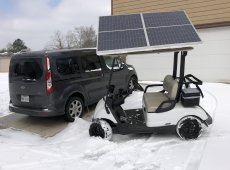mrmrm
New Member
- Joined
- Jan 26, 2022
- Messages
- 11
I just bought a Cub Cadet RZT-S Zero electric lawn mower off craigslist with dead batteries. I'd like to replace the 4 bad AGM batteries with LifePo4 to increase the storage for my home when the mower is not in use.
Current Setup:
2x 5000es
3x EG4 48v 100ah rack mounted.
Mower new batteries:
4x Vestwoods 12v 100ah batteries (these are the only ones that fit the group 27 agm brackets in the mower)
Question:
I assume I'm good just paralleling the "mower pack" into my EG4 rack bus bar. I understand there will probably be some inefficiency or loss due to slightly longer cables going to the mower? But my main question is if I need to match the voltage of the 2 packs (15.3kwh EG4s and 5.12kwh mower pack) when hooking them up to be charged and used for the rest of the week.
In other words can I just wire in an anderson connector to my EG4 pack, unplug the mower, use it, and then just plug it back in so they can balance? Or would the lower voltage of the mower pack then do damage to the EG4s?
Current Setup:
2x 5000es
3x EG4 48v 100ah rack mounted.
Mower new batteries:
4x Vestwoods 12v 100ah batteries (these are the only ones that fit the group 27 agm brackets in the mower)
Question:
I assume I'm good just paralleling the "mower pack" into my EG4 rack bus bar. I understand there will probably be some inefficiency or loss due to slightly longer cables going to the mower? But my main question is if I need to match the voltage of the 2 packs (15.3kwh EG4s and 5.12kwh mower pack) when hooking them up to be charged and used for the rest of the week.
In other words can I just wire in an anderson connector to my EG4 pack, unplug the mower, use it, and then just plug it back in so they can balance? Or would the lower voltage of the mower pack then do damage to the EG4s?




